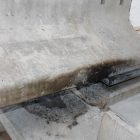 Non-destructive evaluation of unknown foundations and piles has gained interest among engineers and researcher over the past few years. Latest research show the effectiveness of these methods in investigating the depth and quality of existing piles, as well as in the quality assurance of new construction.
Non-destructive evaluation of unknown foundations and piles has gained interest among engineers and researcher over the past few years. Latest research show the effectiveness of these methods in investigating the depth and quality of existing piles, as well as in the quality assurance of new construction.
Piles are structural members made of timber, steel, or concrete. Piles are used to transfer the loads of a heavy superstructure (bridge, high rise building, etc.) to the lower layers of soil.
In the design process, estimating the unknown length of piles and drilled shafts is an important challenge; this remains true for verification and quality assurance of newly constructed foundation. Evaluating the integrity and length of existing piles is another important issue in the assessment of quality and performance of piles. Testing existing piles can be quite challenging as these elements are embedded in the ground, with limited and sometimes impossible access. This is specially true if structural drawings and documentations are missing.
Non-Destructive Evaluation of Unknown Foundations
 Non-Destructive Testing (NDT) methods provide an excellent tool for evaluating the length and integrity of existing piles. Different NDT methods have been developed and tested within the past two decades. A comprehensive study performed by the Bridge Maintenance Office of the Florida Department of Transportation and FHWA investigates and researches testing methods for a cost effective and accurate evaluation of potential risks. As part of this research, the most current and widely used non-destructive testing (NDT) methods for determining the embedment depth of bridge foundations were identified.
Non-Destructive Testing (NDT) methods provide an excellent tool for evaluating the length and integrity of existing piles. Different NDT methods have been developed and tested within the past two decades. A comprehensive study performed by the Bridge Maintenance Office of the Florida Department of Transportation and FHWA investigates and researches testing methods for a cost effective and accurate evaluation of potential risks. As part of this research, the most current and widely used non-destructive testing (NDT) methods for determining the embedment depth of bridge foundations were identified.
Existing NDT Methods
Two general categories of NDT testing is used in evaluating the length of piles:
1- Surface NDT Methods
 Surface NDT methods do not require any soil boring or probe. The main advantage with this group is that they are typically fast, with minimal intrusion. The equipment can easily be moved around the top of the substructure. The traffic disruption caused by this group of tests is often minimal. A major disadvantage to surface NDT are its inability to provide foundation data below a subsurface pile cap (if one exists).
Surface NDT methods do not require any soil boring or probe. The main advantage with this group is that they are typically fast, with minimal intrusion. The equipment can easily be moved around the top of the substructure. The traffic disruption caused by this group of tests is often minimal. A major disadvantage to surface NDT are its inability to provide foundation data below a subsurface pile cap (if one exists).
+ Pile Integrity Test (PIT)
+ Bending Waves with Short Kernel
+ Ultra-Seismic
+ Surface Wave Spectral Analysis
+ Ground Penetrating Radar
+ Dynamic Foundation Response
2- Subsurface NDT
 Subsurface NDT methods require the installation of at least one soil boring or probe. A big advantage of this group of tests is their ability to detect foundations below a subsurface pile cap. One drawback for this group of tests is the fact that they are often more expensive. However, this can be justified by the greater reliability and versatility they offer.
Subsurface NDT methods require the installation of at least one soil boring or probe. A big advantage of this group of tests is their ability to detect foundations below a subsurface pile cap. One drawback for this group of tests is the fact that they are often more expensive. However, this can be justified by the greater reliability and versatility they offer.
+ Parallel Seismic
+ Borehole Radar
+ Borehole Sonic
+ Cross Hole Sonic
+ Induction Field
+ Borehole Magnetic
How to Choose the Right Test?
The selection of proper NDT method comes to the question of accessibility, traffic, and the top part of the substructure, that is whether the piles have cap or not. One should also consider the following when making a decision:
+ Pile material
+ Pile configurations in the foundation layout
+ Pile surrounding area (material)
+ Pile condition (exposed or covered up by pile cap)
+ Ground water level
References
+ Unknown Foundation Bridges Pilot Study; Federal Highway Administration & Florida Department of Transportation; Feb 2010;
+ Application of Non-Destructive Testing to Evaluate Unknown Foundations for Pennsylvania Bridges; Aug 2013
+ Frank Rausche, NON-DESTRUCTIVE EVALUATION OF DEEP FOUNDATIONS, Apr 2004






FOLA ADENIYI
Is it possible to have an image of a buried cast in situ bored concrete piles to a scale with pile configurations?
Count on your swift response
NDT Methods of Piles and Foundations | FPrimeC Solutions
[…] Non-Destructive Evaluation of Unknown Foundations […]
Ellie Davis
I was not aware that non-destructive evaluation can evaluate the quality of existing piles. It makes sense that piles need to be examined every once in a while to ensure durability. As you mentioned, they transfer loads of heavy superstructure to the lower layers of soil, and they need to have proper maintenance.